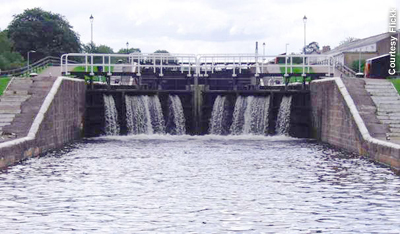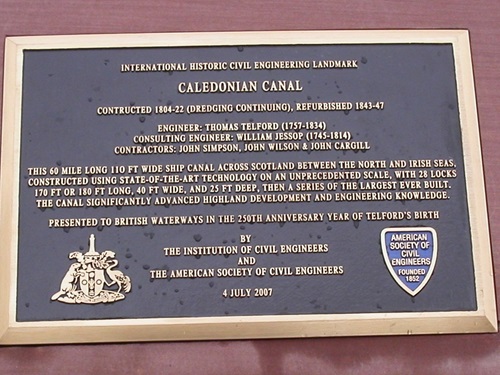Caledonian Canal
57 06 44.9 N, 4 44 18.8 W

At the time, the Caledonian Canal was the largest series of locks ever built. The canal significantly advanced highland development and engineering knowledge.
"So far as the science of engineering was concerned it made a very real contribution to the advancement of engineering knowledge as well of this country's prestige."
-Sir Alexander Gibb, eminent consulting engineer and Telford historian.
Traversing the Great Glen of the Scottish Highlands for 60 miles the Caledonian Canal connects the North Sea by Beauly and Moray Firth on the east coast with the Irish Sea by Lochs Linnhe and Eil on the west. Thirty eight miles of the canal pass through freshwater lochs Douchfour, Ness, Oich and Lochy with the remaining 22 miles formed by earth cutting. Initially 28 locks, and later 29, were required to reach the summit elevation of 106 feet at Loch Oich.
The canal was first proposed by James Watt in 1773 and 20 years later by John Rennie. However, no immediate action resulted. It would be 1803, two years following the issue of Thomas Telford's Highland Report recommending construction of a broad network of roads, canals and harbor improvements throughout the Scottish Highlands, that an Act of Parliament would form the Caledonian Canal Commission, initiating serious work. The main purposes of the canal were to provide an alternate to the hazardous and lengthy sail around the north of Scotland via the Pentland Firth, to provide badly needed employment and to encourage development of the Highlands.
The Caledonian Canal was a massive project for its time. Telford's plan called for a canal 20 feet deep, 50 feet wide at the bottom and 110 feet wide at the top. The locks were 180 feet long by 40 feet wide by 20 feet deep, the largest ever to be constructed until surpassed by the Panama Canal in 1916.
Telford designed the canal with the assistance of his consulting engineer, William Jessop. He then assembled an expert team of earth movers, stone masons, and iron workers who, beginning with an inexperienced labor force, battled difficult access, harsh weather and bad ground conditions for 18 years. Typical of the significant construction engineering problems encountered were the extremely porous gravel soils at the Fort Augustus locks that required extensive dewatering and the soft and deep soils at the Clachnaharry sea-lock that were treated by pre-consolidated fill.
Although it did not live up to the commercial success that was expected, the Caledonian Canal did serve as an important military supply route during World War I. Today, after considerable restoration by British Waterways, it is an important tourist and leisure attraction in the Scottish Highlands. The sheer magnitude of the project and the severe conditions under which it was performed contributed greatly to the advancement of civil engineering knowledge in Britain and beyond.
Resources:
1. Institution of Civil Engineers, International Historic Civil Engineering Landmark Nomination, Caledonian Canal, London 2006
2. Roland Paxton and Jim Shipway, Civil Engineering Heritage, Scotland Highlands and Islands, Thomas Telford 2007, ISBN 978-0-7277-3488-4
3. L.T.C. Rolt, Thomas Telford, Scientific Book Club 1958
4. Photo Image of Caledonian Canal-Laggan from the Royal Commission on Ancient and Historical Monuments of Scotland


